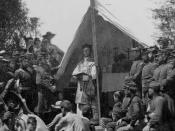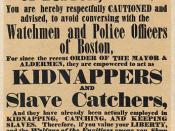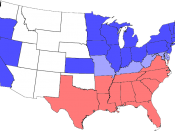Many conflicts between the north and south created sectionalism which is defined as a separation of ideals in different sections of a country. Slavery, the economy, and the disputes over rights all contributed to the sectionalism between the northern and southern states that inevitably lead to the American Civil War in 1861.
The issue of slavery brought about many conflicts between the north and south. In the beginning slavery was not that great of a problem because slavery was naturally dying out because it was costly and inconvenient. However, Eli Whitney's creation of the cotton gin was invented and southerners found this tool helpful even if it required them to have more slaves. They got more slaves to help them grow their cotton and the fact of slavery rising again angered northerners. Northerners found slavery to be unfair and that that it was not economically necessary so they strongly felt it should be illegal.
This greatly contradicted the ideals from the south, which began to increase sectionalism. After many slaves tried escaping to the north to be free, the Fugitive Slave Law of 1850 was made. The Fugitive Slave Act was an act that mandated the return of runaway slaves, regardless of where in the Union they might be situated at the time of their discovery or capture. This angered northerners even more and further increased sectionalism. These laws made northerners feel as if they were supporting slavery. Because northerners did not follow this law it angered southerners because they felt their property should be returned. Many northerners then started publish newspapers and books to try to convince everyone that slavery was a sin. This in return angered many southerners. Thoughts on the issue of slavery strongly differed, and although people were not pushing for it, people thought that a...



You should change your title.
This essay is not about civil wars in general, but simply a brief precis on a particular civil war over 150 years ago in the US.
0 out of 4 people found this comment useful.